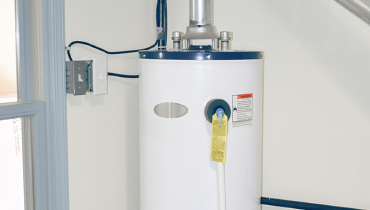
Water heater temperature and pressure relief valves, or T&P valves, are safety features found on all tank water heaters. You need to keep the valve in good working order to ensure the water heater remains safe in the unlikely event of extreme pressure buildup. The valve works by opening temporarily and discharging short spurts of water when the temperature exceeds about 99 degrees Celsius. It also releases pressure if the tank gets above 150 psi.
It’s important to locate your hot water heater pressure relief valve so you can test it at least once a year and address leaks as they occur. We’ll show you how to access and test this valve so you can maintain it and keep your home safe.
Where is the Water Heater Pressure Relief Valve?
The T&P valve is usually located high on the side or on top of the tank. It connects to a pipe that runs down the length of the water heater and stops a few inches above the floor. The valve itself consists of a flat, roughly 4 centimeter long lever that lifts and lowers when releasing water to reduce the temperature and pressure within the tank.
How to Test the T&P Valve
You should test the hot water heater pressure relief valve at least once a year to make sure it functions properly. Now that you know where the T&P valve is located, you can test it with ease.
Make Sure the Valve Works
The most important test is to ensure the T&P valve operates correctly. If it doesn’t, pressure could build up inside the tank and become a safety hazard.
Before you test the T&P valve, make sure a pipe is connected to it that guides discharged water to a floor drain or basin below. Then, lift up on the lever and listen for water discharging from the tank and exiting the pipe near the floor. This indicates a successful test and tells you the valve is working correctly.
If water doesn’t discharge from the valve, or the lever is stuck in the closed position (don’t apply excessive force to open it), this could mean naturally occurring mineral deposits are blocking the waterway, rendering the valve inoperable. Turn off the water heater and call a plumber immediately to replace the valve.
Test for a Valve Leak
If you hear the sound of trickling water coming from the hot water heater, the T&P valve may be leaking. This could mean that you have a defective valve that needs replacement. It could also indicate that the water pressure regulator valve or thermostat is faulty.
All of the potential reasons for a leaky T&P valve demand attention, but first you must test whether your valve is leaking. Check for water pooling around the tank. Then, touch the drain line with your hand to see if it feels warm. If so, this is where hot water is leaking out of the tank. Hire a plumber to determine the cause of the leak and replace the hot water heater pressure relief valve if necessary.
Contact Mr. Rooter Plumbing for Water Heater Repair
Many manufacturers require an inspection and replacement of the T&P valve every two to four years, depending on local water conditions. Any signs of corrosion or scaling indicate the need for an immediate part replacement.
If you notice problems with your water heater, or you can’t remember the last time you had the pressure relief valve inspected or replaced, schedule an appointment for water heater repair today!

